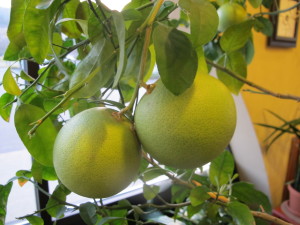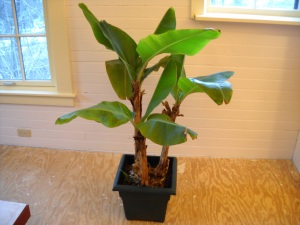Growing Fruit Indoors
When I was a boy of eight or nine I planted a grapefruit seed, hoping it would produce a tree that would provide us with a nice source of winter fruit. Ten years later it was 3 to 4 feet tall, with nice shiny leaves. I went off to college, leaving it in the care of my houseplant-challenged mom. Unfortunately, it pined for me and died a slow death – probably due to overwatering.
My grapefruit tree never blossomed in the 10 years I cared for it. So I was amazed to encounter a grapefruit tree loaded with fruit in the south-facing windows of my optometrist, Dr. Chris Fields in Lebanon, NH. He told me that he had planted seeds 22 years ago when his son was born, and that this was its second year of producing fruit.
Dr. Fields said it bloomed magnificently this past spring and that he went around with a paint brush, transferring pollen from stamens to pistils. The year before he had allowed moving air to do the pollinating, and he had fewer fruits. Some of his fruit felt heavy and full of moisture, others felt light – as if they were made of green Styrofoam. Huh. He’s not sure if they will fill up later.
Meanwhile, I am experimenting with my pineapple plant. I reported in this column last summer that I had bought a pineapple plant, even though I was told that after harvesting its one fruit, the plant would die. I ate the fruit in July and kept it going all summer, enjoying the large, shiny strap-like leaves.
Each fall I pick the “team” of plants that get to come inside for the winter, and competition for window space is tough. The pineapple did not make the team this fall, and after a few hard frosts I went to clean out the pot for winter storage. Much to my surprise, there were two new green shoots growing beneath the frosted leaves, and the root system appeared vigorous.
So I cut off all the old, dead leaves and re-potted the youngsters and brought them in. We shall see what happens, but my mouth is watering as I think about the fresh pineapples I (may) get next summer, or perhaps the summer after. It’s always fun to experiment.
Back when I was a kid a common school project was to start an avocado plant by suspending a pit by three toothpicks in a glass of water, allowing the base to just kiss the water. But when I tried that a few years ago, I was unable to get one growing. I asked Mrs. Google, and she explained why: avocados need to be started soon after picking. And with modern refrigeration techniques, avocados can be kept edible for months – but older fruits will not start new plants from their pits. Makes sense.
In the fall of 2013 I spotted an avocado plant growing in the compost pile and rescued it, potting it up and giving it a place for the winter. These last two summers it has lived on the deck, getting sun and rain and generally enjoying life outdoors. It is now 30 inches tall, and the stem is half an inch in diameter. Of course I remember avocado trees from my time in the Peace Corps in West Africa – they were bigger than full-sized apple trees here when they were loaded with fruit, so I doubt that mine will ever be anything but a handsome houseplant.
I bought a small banana plant a dozen years or more ago, and kept it outdoors on my deck each summer, bringing it in for the winter ever since. It came with the variety name ‘Cavendish’ which is what most commercial bananas are.
In a 12-inch pot the banana plant got about 3 feet tall, but never taller. And it never hinted at producing fruit – though it did create several other small banana plants that could be dug and re-potted. This year I gave it to Dr. Fields – if he can get a grapefruit tree to produce, maybe he’ll get the bananas to produce, too. I told him that I want one of the bananas if it produces, though.
So Santa Claus, if you are reading this, here is my wish: I want a lemon or lime tree that will produce fruit for me here in Cornish Flat, New Hampshire. Yes, I know, Santa, that I have apples, plums and pears that produce nice fruit outdoors. But that is not the same. I want fresh citrus in winter, and know a number of people who have succeeded in growing lemons or limes indoors. And I’ve been a good boy this year … mostly.
Henry is a gardener who will try growing almost anything once. His email address is henry.homeyer@comcast.net. Let him know if you ever got a banana tree to produce. His mailing address is POB 364, Cornish Flat, NH 03746. He is the author or 4 gardening books.
Growing Fruit
I try not to be too compulsive, but admit that I counted every sour cherry I picked from my tree this year. Give or take a few I ate while picking, I got 111 cherries -not enough for a pie. I planted the tree some 15 years ago, and this was my best crop. Last year I threatened it with the chain saw, and it upped its production from 5 or 6 to over 100 cherries. Maybe next year it will produce a thousand. Maybe not. I’ll probably cut it down.
Fruit trees, I’ve always been told, do not like “wet feet”. By that I mean their roots should be in soil that is not consistently wet. Apples, pears, peaches, cherries, and plums grow best in rich soil with full sun and well drained but lightly moist soil. Most of my full sun is alongside a brook with a water table that is consistently high – within two feet in dry times, a foot or less in spring. So, back in the 1980’s, when I was young and full of pep, I built a terrace to grow fruit trees.
A friend had a dilapidated stone wall along his road that he had picked over, taking the nicest flat stones for a wall elsewhere on his land. But he said I could take anything I wanted, warning me that building with round stones is not easy. It wasn’t. But the price was right, and I had a little trailer, so I hauled rocks, a dozen at a time, to my back yard. I built an 80-foot retaining wall, and bought topsoil to backfill behind it. The truck couldn’t get to the site, so I moved many dump truck-loads the final distance by wheelbarrow. Ah, to be young and foolish again.
I tell you all this because I feel like I‘ve done a lot for this darn cherry tree, and I’m pretty sure I’ll cut it down this year or next. I know my e-mail inbox will be full of mail asking me to spare the tree. But my thought is this: if a tree does not live up to your expectations and you have given it a fair chance, get out the chain saw. I have limited space for fruit trees. And 111 cherries is not worth the space. The blossoms are not special, either.
The irony is that since I built the wall and planted fruit trees, I have had good luck planting them in the field near my stream. I just built up something akin to a major league pitcher’s mound, and planted where the pitcher would stand. Ten feet across, and rising up about a foot. I’ve planted plums and apples, and all have done fine. So maybe that old saying about fruit trees not liking wet feet is bogus.
Meanwhile, I mowed down my blackberry patch earlier this summer. I planted a 50-foot row about 30 years ago, and the patch has slowly gone downhill. For many years it was great, and I was only able to keep the bushes contained with a mower. But recently each year there were more fungal diseases, and less production. So I will hire someone to plow the land, and rototill the roots. Then I will cover it with black plastic for the rest of the summer to kill the weeds and roots.
Next year I will plant that patch in strawberries. I will plant some June-bearing plants, probably ‘Earliglow’, that produce their entire crop in a 3-week period. They are great for freezing, and for general gluttony. It’s great to eat strawberries three times a day for a while. But I will also plant some day-neutral berries or everbearing plants that will produce smaller numbers over a longer period.
Most strawberries depend on the length of the day to tell them when it is time to produce fruit. Day-neutral berries are not dependent on that cue. The last time I grew day-neutral berries I got a nice fall crop the first year, then some berries all summer the following years, with a bigger bump in the fall. I planted ‘Tristar’ and was pleased with it. The berries were smaller than most June berries, the size of a dime to a quarter. No fifty-cent sized berries. Commercial growers in California often plant day-neutral berries so they can sell berries all year.
This spring I was at Edgewater Farm in Plainfield, NH and was seduced by a lovely pineapple plant. It displayed lots of long, strap-like leaves similar to that of an aloe plant. And best of all, it had a pineapple growing on top! It was expensive – twenty-five dollars – but I bought it anyway. I knew, from living in Africa, that pineapples plants only produce one fruit, then die. But I also knew that it is possible to start a second plant from the first.
My pineapple lived on the deck in partial sunshine and was a very nice addition to the plants there. But, come mid-July the fruit ripened to a deep yellow and then flopped over on its stem. I tied it up. It flopped anyway. I decided it was time to eat it. It was tasty, but barely one serving after peeling and coring it. Right now the plant looks good, and I’m hoping it will develop a side-shoot. If not, the experiment will be done. Meanwhile, my avocado plant I started from a pit is doing great.
Fruit is a great investment. Plant a fruit tree, sit back and relax, harvest the fruit. That’s the ideal. In fact, my cherries cost me many dollars each, if I add in the cost of the tree, the soil, and minimum wage for my time building the wall to create the space. And you know what? The cherries aren’t even very good eating! Live and learn.
Henry Homeyer is a UNH Master Gardener and the author of 4 gardening books. His web site is www.Gardening-Guy.com.







